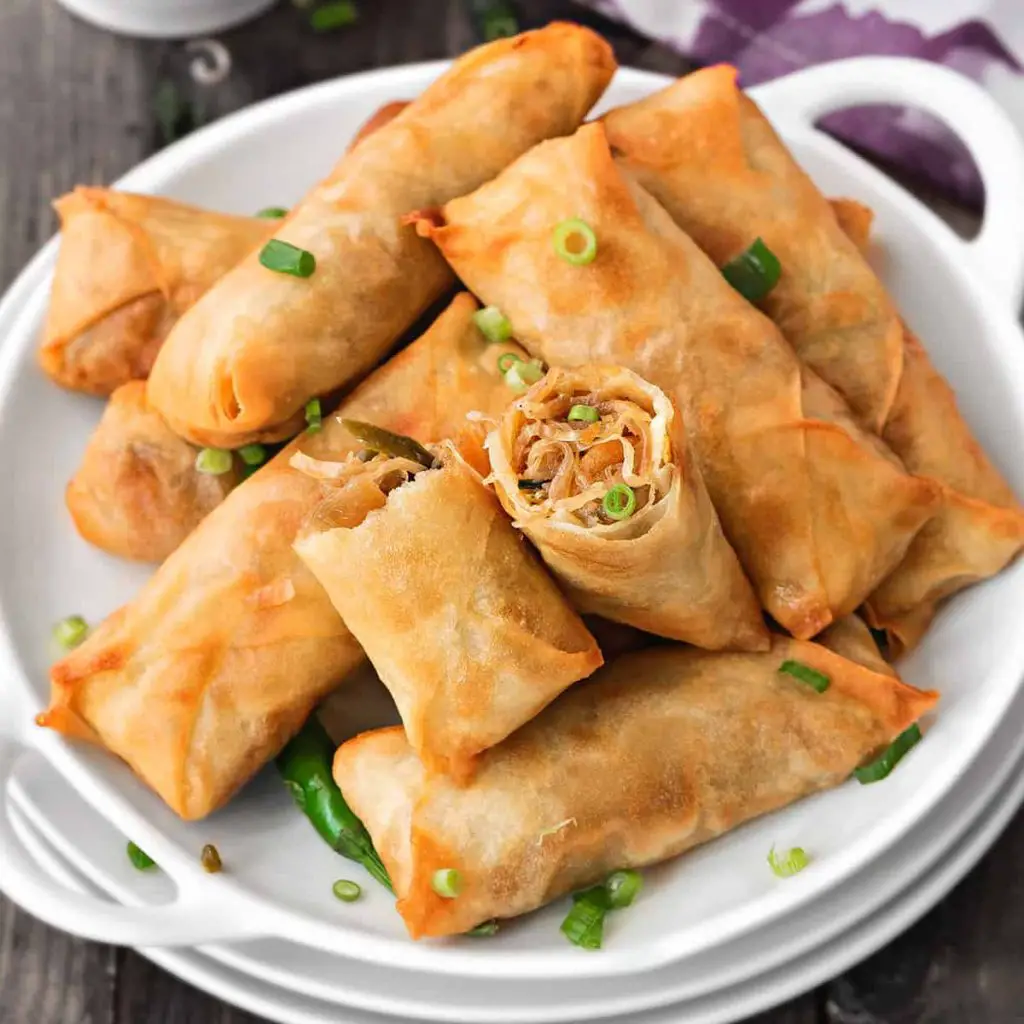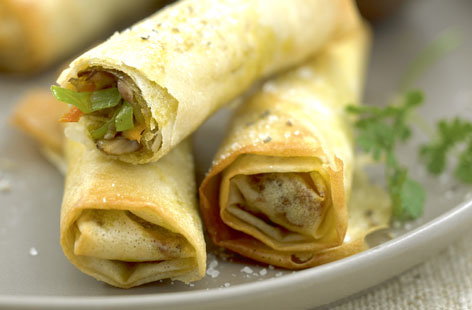Spring rolls are a popular appetizer or snack in many countries around the world.
The name “spring roll” is derived from the traditional Chinese practice of eating these snacks during the spring season.
While the ingredients in spring rolls vary depending on region, they typically include vegetables or meat wrapped in a thin pastry dough.
Let’s take a closer look at this tasty treat.
Contents
Are Spring Rolls Healthy?
The answer depends on the filling and how you prepare them.
Generally speaking, spring rolls are a healthy snack or meal option that can be made with a variety of nutritious ingredients.
For example, traditional Vietnamese spring rolls filled with vegetables like lettuce, carrots, vermicelli noodles, and herbs are low in calories and contain no animal products. Spring rolls can also be filled with lean proteins such as chicken or shrimp, adding an extra boost of nutrition.

When purchasing pre-made spring rolls from the grocery store or a restaurant, it’s important to look out for added sugar and unhealthy fats in the ingredients list.
For a truly healthy option, make your own spring rolls at home using fresh, whole ingredients. Remember to watch your portion size and opt for healthy dipping sauces such as natural peanut butter or low-sodium soy sauce.
In moderation, spring rolls can be a delicious and nutritious part of a balanced diet. Whether you choose to make them from scratch or purchase them pre-made, keep an eye on the ingredients to ensure you’re getting the most nutritional bang for your buck. Enjoy!
What Is the Difference Between Spring Rolls and Egg Rolls?
1. The Key Ingredient: The Wrapper:
One of the most obvious differences between spring rolls and egg rolls is the wrapper. Spring roll wrappers are made from wheat flour and water, whereas egg roll wrappers are made from wheat flour, eggs, salt, and water.
As a result, egg roll wrappers tend to be thicker than spring roll wrappers.
This difference also affects how each type of wrapping holds up during cooking; egg roll wrappers stay crispy for longer due to their thicker consistency.
2. The Filling: What’s Inside?
Spring rolls typically contain some combination of vegetables like cabbage, carrots, mushrooms, bamboo shoots, and bean sprouts.
These ingredients are usually lightly cooked or raw in order to retain their crunchy texture.
In contrast, egg rolls usually contain ground pork or shrimp as well as vegetables like cabbage or onions. The meat is usually pan-fried before being added to the filling mixture in order to give it more flavor.
3. The Cooking Process: How Are They Prepared?
Another key difference between spring rolls and egg rolls is how they are cooked. Spring rolls are generally deep-fried until they become golden brown and crispy on the outside while retaining their crunch on the inside.
Egg rolls are also deep-fried but require a slightly longer cooking time in order to cook through all of their layers properly.
What Are The Different Types of Spring Rolls?
Today, there are countless variations of this classic snack from all over the world. In Vietnam, for example, you can find spring rolls filled with shrimp or pork and served with a spicy dipping sauce.
In Japan, you can try tempura-style spring rolls that are filled with seafood and vegetables then battered and deep fried; while in Thailand they serve fresh spring rolls that are filled with noodles, lettuce, and herbs like cilantro or mint.
Other regions also have their own unique takes on this iconic dish like Filipino lumpia which is usually filled with ground pork or beef plus vegetables like carrots and onions.
Korean kimchi pancakes feature fermented cabbage plus scallions; Indonesian lumpia which is similar to Filipino lumpia but often made with a thinner wrapper.
Indian samosas which feature savory fillings such as potatoes or lentils encased in a flaky pastry; and Nepalese momo dumplings that are typically stuffed with meat such as chicken or beef plus spices like turmeric or cardamom.
Are Spring Rolls Good for Weight Loss?
While spring rolls can be a healthy option when made with nutritious ingredients like vegetables and lean proteins, they are not necessarily the best choice if your goal is weight loss.
This is because they often contain added sugar and unhealthy fats.
Additionally, many restaurant versions of spring rolls contain a lot more calories than their homemade counterparts.
If you’re trying to lose weight, it’s important to pay close attention to your portion size and use caution when adding high-calorie dipping sauces or condiments.
Additionally, try making spring rolls at home with healthy ingredients like vegetables, lean proteins, and whole grains for an even more nutritious meal.
By swapping out deep-fried spring rolls for a lighter version like wraps or lettuce cups, you can enjoy the flavors of traditional spring rolls but with fewer calories.
With some creative ingredient swaps and mindful eating habits, spring rolls can be part of an overall healthy diet. Just make sure to keep an eye on your portions!
Are Chinese Spring Rolls Healthy?
Chinese spring rolls can be a healthy choice depending on the ingredients.
Traditional Chinese spring rolls are usually filled with vegetables and lean proteins like pork, shrimp, or tofu. They are often wrapped in thin pastry wrappers which contain very few calories.

As long as the rest of the filling is free from unhealthy fats and added sugar, Chinese spring rolls can make a nutritious snack or meal component.
When ordering Chinese spring rolls at a restaurant, look out for added sugar and unhealthy fats in the ingredients list.
Additionally, watch your portion size to ensure you’re not overeating.
For a healthier option, try making your own Chinese spring rolls at home with fresh, whole ingredients like lean proteins, vegetables, and whole grain wrappers. Enjoy!
Are Spring Roll Rice Papers Healthy?
Spring roll rice papers are a popular ingredient for making Vietnamese-style spring rolls.
They are thin, translucent wrappers made from rice flour and tapioca starch that are used to wrap the filling.
While traditional spring roll rice papers contain very few calories (approximately 25 calories per wrapper), it’s important to look out for added sugar and unhealthy fats in the ingredients list.
When making spring rolls at home, it’s best to opt for whole grain wrappers or lettuce cups instead of rice paper wrappers. This way you can still enjoy the flavor and texture of traditional spring rolls without the added calories.
Additionally, watch your portion size when eating pre-made spring rolls to ensure you’re not overeating. With some mindful eating habits, spring roll rice papers can be part of a balanced diet.
Do Spring Rolls Have a Lot of Carbs?
Spring rolls can contain a variety of different ingredients, so the number of carbs can vary depending on what’s inside.
However, in general, spring rolls tend to be higher in carbohydrates than other types of food due to the wrappers and fillings. Most wrappers are made from rice flour or wheat flour which is high in carbohydrates.
Additionally, some fillings can also contain added sugars or high-carb ingredients like noodles.
If you’re trying to watch your carbohydrate intake, look out for added sugar and high-carb fillings when choosing spring rolls.
Additionally, consider making your own spring rolls at home with healthier wrappers like lettuce cups or whole wheat flour and fillings with fewer carbohydrates. With some mindful eating habits, spring rolls can still be part of a balanced diet.
Just make sure to keep an eye on your portion size and the ingredients that you’re using.
Why Are Vietnamese Spring Rolls Healthy?
Vietnamese spring rolls, also known as salad rolls or summer rolls, are a popular appetizer or light meal. They are typically filled with vegetables, lean proteins like shrimp or tofu, and herbs wrapped in thin rice paper wrappers.
Vietnamese spring rolls are an excellent choice for those looking to enjoy a healthy snack or meal because they contain relatively few calories, are packed with fresh vegetables and lean proteins, and have no added sugar or unhealthy fats.
Additionally, Vietnamese spring rolls can be easily customized to suit a variety of dietary needs.
For example, you can use gluten-free wrappers or switch out the protein for a vegetarian option. With some creativity and mindful eating habits, Vietnamese spring rolls can be an excellent choice for a nutritious snack or meal. Enjoy!
How Many Calories Are in a Chinese Takeaway Spring Roll?
The number of calories in a Chinese takeaway spring roll can vary significantly depending on the ingredients used. In general, traditional deep-fried Chinese spring rolls can have up to 200 calories each due to the added fats from frying.
Additionally, some takeout spring rolls may contain added sugar or unhealthy fats in the fillings which can increase their calorie count.
If you’re trying to watch your calorie intake, consider making your own spring rolls at home with fresh ingredients and healthier wrappers like lettuce cups or whole wheat flour. This way you can still enjoy the flavor of traditional Chinese takeaway spring rolls without all the added calories.
Additionally, watch your portion size when eating pre-made spring
Are Rice Paper Wrappers Healthy?
Rice paper wrappers are a popular ingredient used to make traditional spring rolls. While they cont
Rice paper wrappers can be part of a healthy diet as long as you pay attention to the other ingredients that you’re using and watch your portion size. It’s important to look out for added sugar and unhealthy fats in the fillings and to choose lean proteins, fresh vegetables, and whole grain wrappers whenever possible.
Additionally, consider making your own spring rolls at home with healthier ingredients like lettuce cups or whole wheat flour. This way you can still enjoy the flavor in relatively few calories, they are also generally low in fat and protein.
If you’re looking for a light snack or meal, rice paper wrappers can be an excellent choice. Just make sure to watch your portion size and choose healthier fillings.
Are Spring Roll Wrappers Fattening?
Spring roll wrappers can have varying levels of fat depending on the ingredients used. Generally, spring rolls made with rice paper or whole wheat flour will be lower in fat than those made with refined white flour.
Additionally, some fillings may contain unhealthy fats like deep-fried foods or added sugars which can increase the calorie count and fat content of a spring roll.
If you’re looking to keep your fat intake to a minimum, consider making your own spring rolls at home with healthier wrappers like lettuce cups or whole wheat flour and fillings with fewer carbohydrates.
Conclusion:
With some mindful eating habits, spring rolls can still be part of a balanced diet. Just make sure to keep a watchful eye on your portion size and be mindful of what ingredients you’re using.
No matter what type you choose to try, one thing is certain—spring rolls make for an incredibly delicious snack!
Whether you go for the classic Chinese version made with pork and vegetables or something more exotic like Japanese tempura-style spring rolls or Nepalese momo dumplings—there’s no wrong way to enjoy this beloved dish. So why not give it a try yourself? You won’t regret it!
Amazon and the Amazon logo are trademarks of Amazon.com, Inc, or its affiliates.

